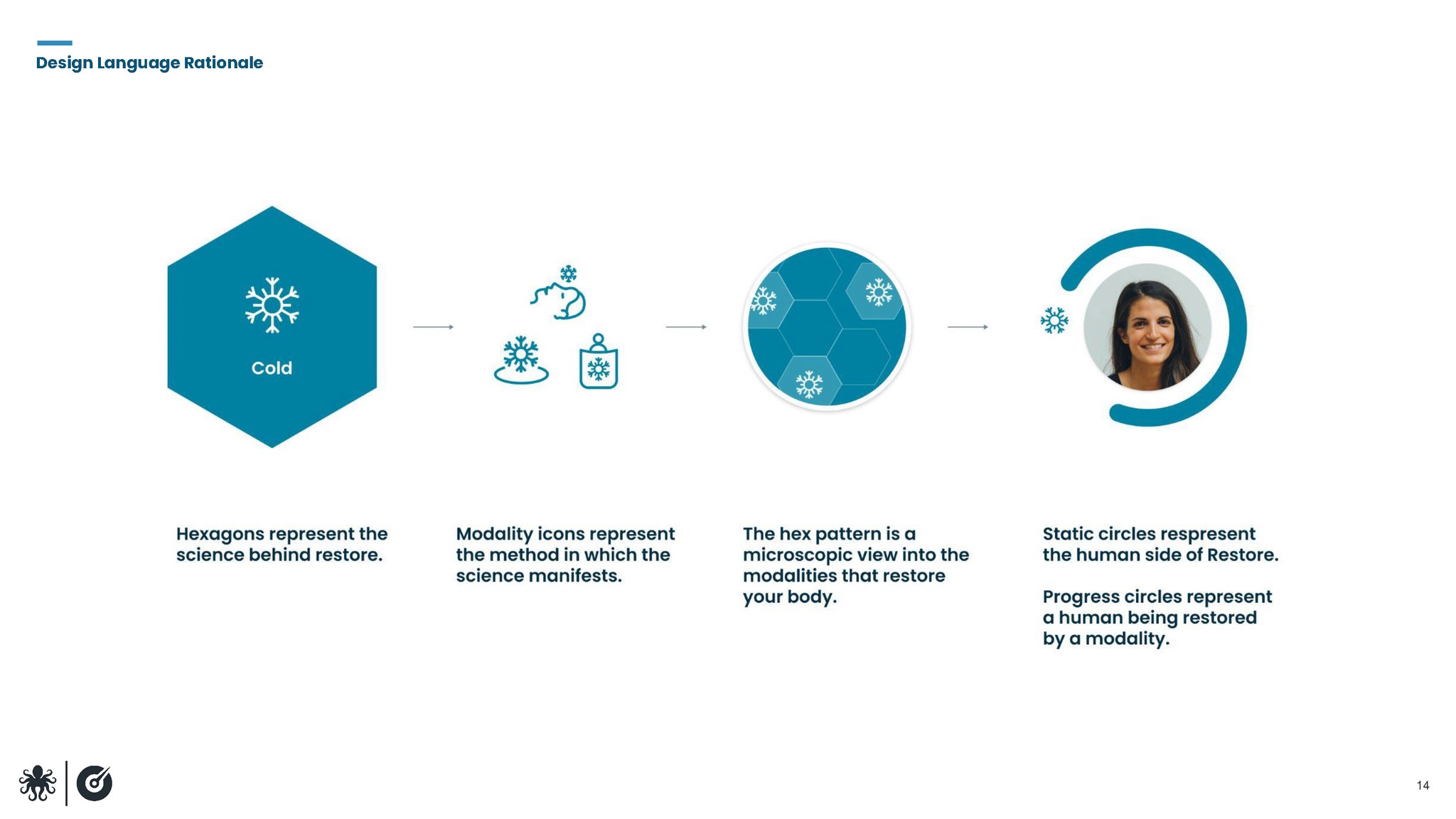
Restore CX Blueprint
Designer | Researcher | 13 Weeks
Restore CX Blueprint
Designer | Researcher | 13 Weeks
Project Overview
Restore Hyper Wellness, an award-winning pioneer in the wellness field, has revolutionized the industry by introducing an innovative category of care. Boasting a network of over 100 locations and franchises, Restore offers a diverse range of services including cryotherapy, IV drip therapy, and biomarker assessments. As the company experienced rapid scaling and growth, it sought the expertise of argoDesign to further elevate its customer and user experience across all brand touchpoints.
Project Overview
Restore Hyper Wellness, an award-winning pioneer in the wellness field, has revolutionized the industry by introducing an innovative category of care. Boasting a network of over 100 locations and franchises, Restore offers a diverse range of services including cryotherapy, IV drip therapy, and biomarker assessments. As the company experienced rapid scaling and growth, it sought the expertise of argoDesign to further elevate its customer and user experience across all brand touchpoints.
Our Team's Challenge & Deliverables
Research employee, franchise, and customers’ needs to inform Restore’s customer experience strategy. Our deliverables include an initial website expression, a hero flow across major touch points, and a service framework.
Our Team's Challenge & Deliverables
Research employee, franchise, and customers’ needs to inform Restore’s customer experience strategy. Our deliverables include an initial website expression, a hero flow across major touch points, and a service framework.
What did we want to achieve?
Improved Customer Satisfaction: Measurable increase in customer satisfaction scores post-implementation.
Increased Efficiency: Streamlined operations leading to reduced wait times and enhanced customer service.
Enhanced Employee Performance: Better-trained staff with access to relevant customer information improved service delivery and customer relationships.
Higher Sales Conversion: More effective lead generation and sales strategies resulted in increased customer acquisition and retention.
What did we want to achieve?
Improved Customer Satisfaction: Measurable increase in customer satisfaction scores post-implementation.
Increased Efficiency: Streamlined operations leading to reduced wait times and enhanced customer service.
Enhanced Employee Performance: Better-trained staff with access to relevant customer information improved service delivery and customer relationships.
Higher Sales Conversion: More effective lead generation and sales strategies resulted in increased customer acquisition and retention.
How were we going to achieve it?
Brand & Product Immersion: Conducted a modality and experience audit on-site at multiple Restore locations. Brand and tech audit with stakeholders to gather constraints, and a hypothesis co-creation with key stakeholders.
User Research: Conducted interviews, surveys, and observations to gather data on customer behavior, preferences, and pain points.
Ideation and Prototyping: Developed wireframes and prototypes to address identified challenges, focusing on improving customer interaction touchpoints.
Usability Testing: Tested prototypes with real users to gather feedback and iteratively refine the design.
Implementation: Rolled out the redesigned elements in phases, prioritizing high-impact areas.
Training and Support: Provided comprehensive training to staff on new systems and ongoing support for smooth adoption.
How were we going to achieve it?
Brand & Product Immersion: Conducted a modality and experience audit on-site at multiple Restore locations. Brand and tech audit with stakeholders to gather constraints, and a hypothesis co-creation with key stakeholders.
User Research: Conducted interviews, surveys, and observations to gather data on customer behavior, preferences, and pain points.
Ideation and Prototyping: Developed wireframes and prototypes to address identified challenges, focusing on improving customer interaction touchpoints.
Usability Testing: Tested prototypes with real users to gather feedback and iteratively refine the design.
Implementation: Rolled out the redesigned elements in phases, prioritizing high-impact areas.
Training and Support: Provided comprehensive training to staff on new systems and ongoing support for smooth adoption.

Auditing Restore's "12 Experience Values"
In the competition for customers, twelve emotions provide the most recognized value. These emotions are experienced through a brand's touch points.
Our goal was to design Restore's touch points to elicit the recognized values positively — amplifying emotional values.
Auditing Restore's "12 Experience Values"
In the competition for customers, twelve emotions provide the most recognized value. These emotions are experienced through a brand's touch points.
Our goal was to design Restore's touch points to elicit the recognized values positively — amplifying emotional values.
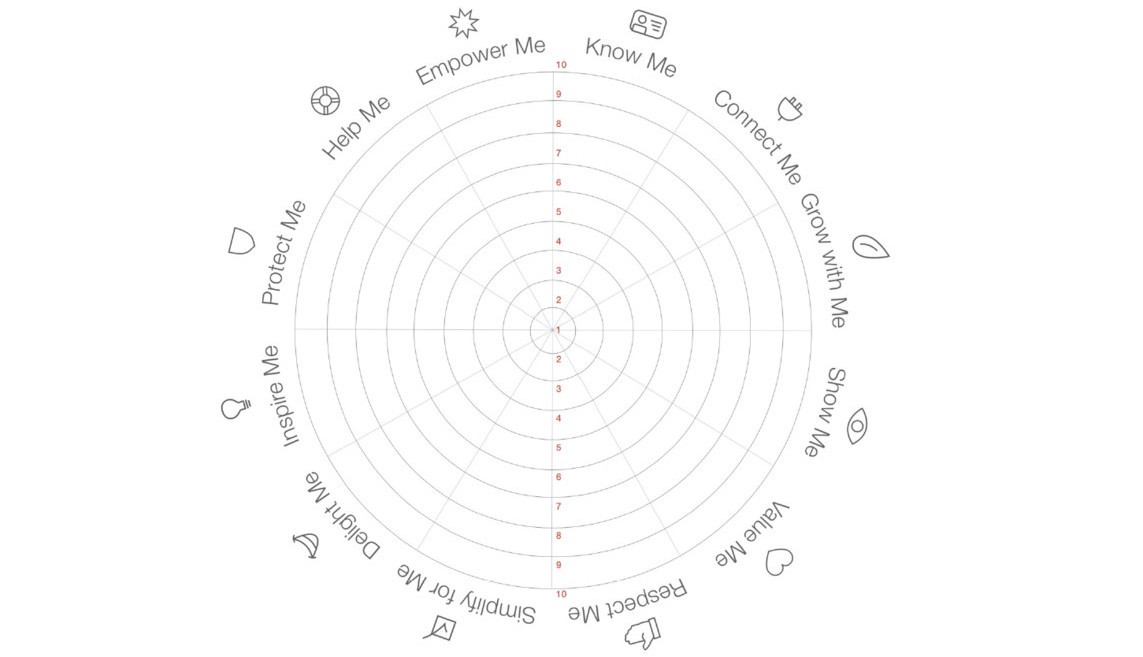

Restore's Current Experience & Opportunities
After conducting all of our audits across Restore's touch points, we delivered their brand's current orchestration. The findings revealed a mix of strengths and weaknesses in their approach. Now, let's delve into some of the more troubling areas that emerged from our analysis, to understand where and how improvements can be made.
Clearer customer value prop, humanized approach.
New customer onboarding to member conversion.
Simpler modality framework, simpler pricing framework.
Authenticated web/app experience.
Employee frameworks to help serve and sell.
Franchise service offering and CX consistency.
Focus on the mission.
Restore's Current Experience & Opportunities
After conducting all of our audits across Restore's touch points, we delivered their brand's current orchestration. The findings revealed a mix of strengths and weaknesses in their approach. Now, let's delve into some of the more troubling areas that emerged from our analysis, to understand where and how improvements can be made.
Clearer customer value prop, humanized approach.
New customer onboarding to member conversion.
Simpler modality framework, simpler pricing framework.
Authenticated web/app experience.
Employee frameworks to help serve and sell.
Franchise service offering and CX consistency.
Focus on the mission.

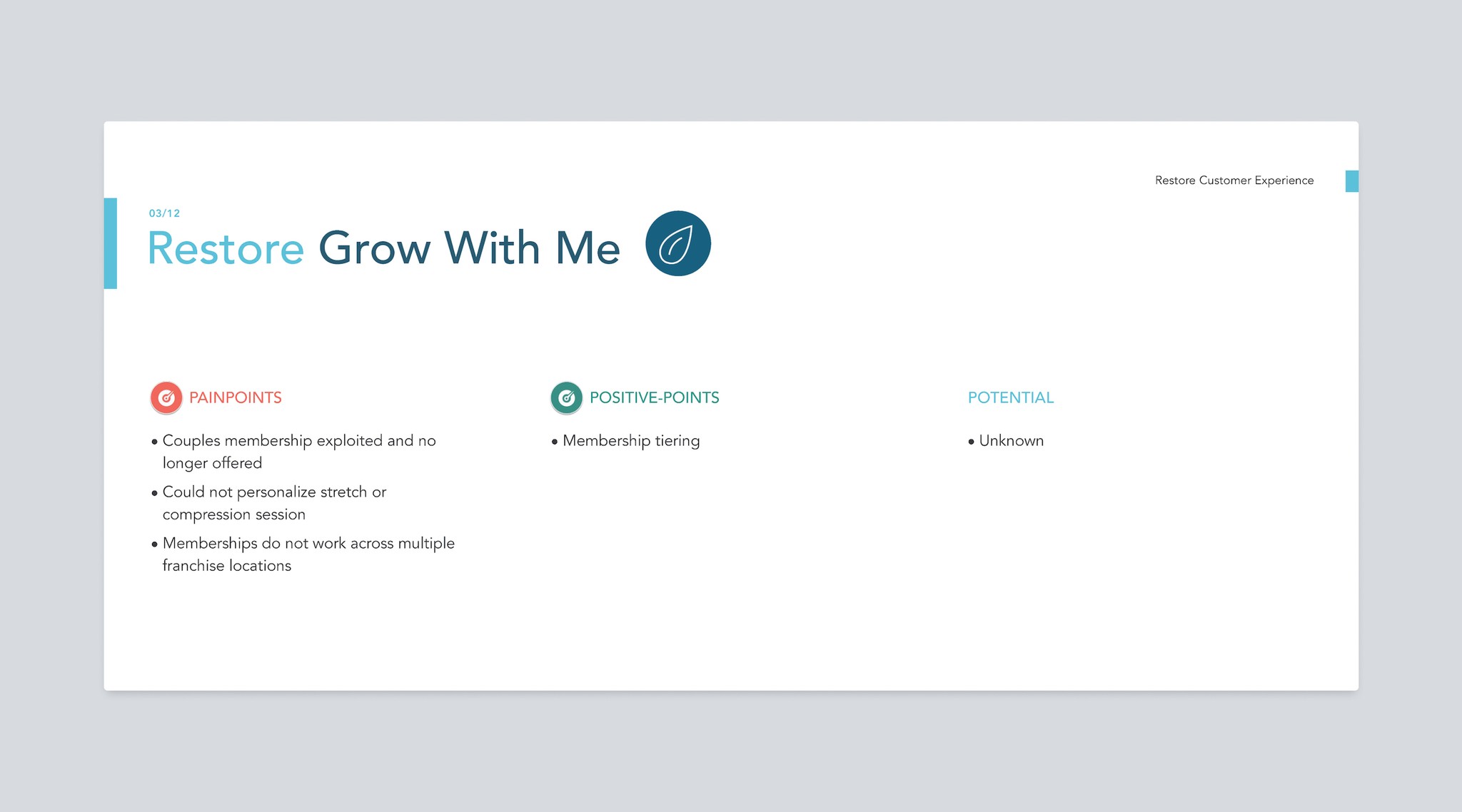


Planned Hypotheses
Modality & Plan Guide: Benefitting both the employee and the consumer, the trifold is meant to help simplify the paradox of choice.
Dial Credit System: Dial-based credit system is meant to simplify, allow for customization, and appeals to customers with varying budgets while increasing member usage and retention.
Point of Wellness: A redesigned, proprietary Point of Sale system is meant to streamline appointments, retail, and customer management for employees.
Restore App & Tech Stack: A new and integrated tech stack powered by Salesforce is meant to personalize the customer experience and bring value through data tracking.
In-Store Experience: New stores will have an updated look that maintains brand consistency and includes wall vinyls which communicate the value prop and brand message.
Signature Scents & Playlists: A signature scent and in-store playlist could have the potential to further connect customers to the state of "Hyper Wellness".
Planned Hypotheses
Modality & Plan Guide: Benefitting both the employee and the consumer, the trifold is meant to help simplify the paradox of choice.
Dial Credit System: Dial-based credit system is meant to simplify, allow for customization, and appeals to customers with varying budgets while increasing member usage and retention.
Point of Wellness: A redesigned, proprietary Point of Sale system is meant to streamline appointments, retail, and customer management for employees.
Restore App & Tech Stack: A new and integrated tech stack powered by Salesforce is meant to personalize the customer experience and bring value through data tracking.
In-Store Experience: New stores will have an updated look that maintains brand consistency and includes wall vinyls which communicate the value prop and brand message.
Signature Scents & Playlists: A signature scent and in-store playlist could have the potential to further connect customers to the state of "Hyper Wellness".
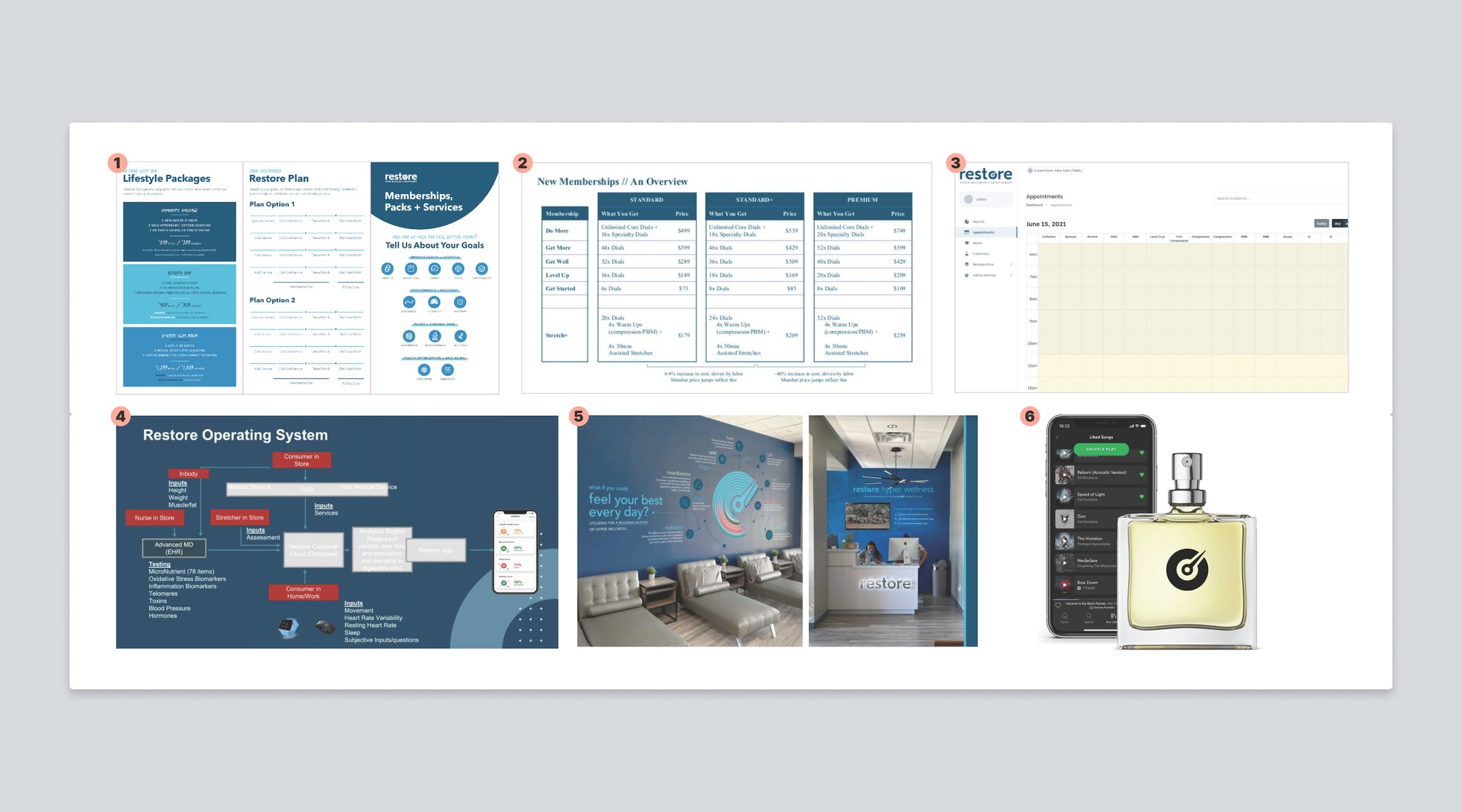
Research Framework & Execution
Our research framework was meticulously designed to gain a comprehensive understanding of both employee experiences and customer interactions within a wellness franchise model. The framework centered on qualitative methods, employing a mix of in-depth interviews, observational studies, and interactive workshops.
Key Components of the Framework:
Employee Interviews and Surveys: To gather insights on employee satisfaction, challenges, and perceptions, we conducted structured interviews and surveys with a cross-section of staff, including wellness professionals, nurses, and sales representatives.
Customer Journey Mapping: To understand the customer's experience, we employed journey mapping techniques, tracking their interactions from initial contact through various service touchpoints to post-visit feedback.
Observational Studies: Observing customer and staff interactions in real-time provided invaluable insights into the service delivery process, customer engagement, and the effectiveness of the current operational model.
Interactive Workshops: Workshops involving both employees and customers were organized to ideate on potential improvements, gather feedback on existing services, and co-create solutions for identified challenges.
Data Analysis and Synthesis: The gathered data was analyzed using thematic analysis to identify key patterns and insights. This comprehensive approach ensured a holistic view of the organization from both internal and external perspectives.
Execution of Research:
The research was executed in phases, starting with preliminary data collection through employee interviews, followed by customer-focused studies and observational research. The interactive workshops served as a platform to validate findings and generate collaborative solutions. Throughout the process, we maintained a flexible approach, adapting our methods to the evolving needs of the research while ensuring a rigorous and systematic collection of data.
This multi-faceted research approach enabled us to derive actionable insights, ensuring that our UX design recommendations were grounded in real-world experiences and needs. The findings from this research form the foundation of our UX design strategy, aiming to enhance both the employee experience and customer satisfaction.
Research Framework & Execution
Our research framework was meticulously designed to gain a comprehensive understanding of both employee experiences and customer interactions within a wellness franchise model. The framework centered on qualitative methods, employing a mix of in-depth interviews, observational studies, and interactive workshops.
Key Components of the Framework:
Employee Interviews and Surveys: To gather insights on employee satisfaction, challenges, and perceptions, we conducted structured interviews and surveys with a cross-section of staff, including wellness professionals, nurses, and sales representatives.
Customer Journey Mapping: To understand the customer's experience, we employed journey mapping techniques, tracking their interactions from initial contact through various service touchpoints to post-visit feedback.
Observational Studies: Observing customer and staff interactions in real-time provided invaluable insights into the service delivery process, customer engagement, and the effectiveness of the current operational model.
Interactive Workshops: Workshops involving both employees and customers were organized to ideate on potential improvements, gather feedback on existing services, and co-create solutions for identified challenges.
Data Analysis and Synthesis: The gathered data was analyzed using thematic analysis to identify key patterns and insights. This comprehensive approach ensured a holistic view of the organization from both internal and external perspectives.
Execution of Research:
The research was executed in phases, starting with preliminary data collection through employee interviews, followed by customer-focused studies and observational research. The interactive workshops served as a platform to validate findings and generate collaborative solutions. Throughout the process, we maintained a flexible approach, adapting our methods to the evolving needs of the research while ensuring a rigorous and systematic collection of data.
This multi-faceted research approach enabled us to derive actionable insights, ensuring that our UX design recommendations were grounded in real-world experiences and needs. The findings from this research form the foundation of our UX design strategy, aiming to enhance both the employee experience and customer satisfaction.

Executive Research Summary & Topic Affinitization
Key Findings:
Restore can be a one stop shop for wellness
Onboarding is inconsistent
Pricing continues to be problematic
Some want guidance, other do not
Restore affordability is questionable as a promise
Community is not a current priority for customers
Our team created 12 categories to serve as a guide for understanding participants' current mental models throughout their journey at Restore shown below.
Executive Research Summary & Topic Affinitization
Key Findings:
Restore can be a one stop shop for wellness
Onboarding is inconsistent
Pricing continues to be problematic
Some want guidance, other do not
Restore affordability is questionable as a promise
Community is not a current priority for customers
Our team created 12 categories to serve as a guide for understanding participants' current mental models throughout their journey at Restore shown below.

Survey Responses
Examples below show a sample of our survey responses.
Survey Responses
Examples below show a sample of our survey responses.

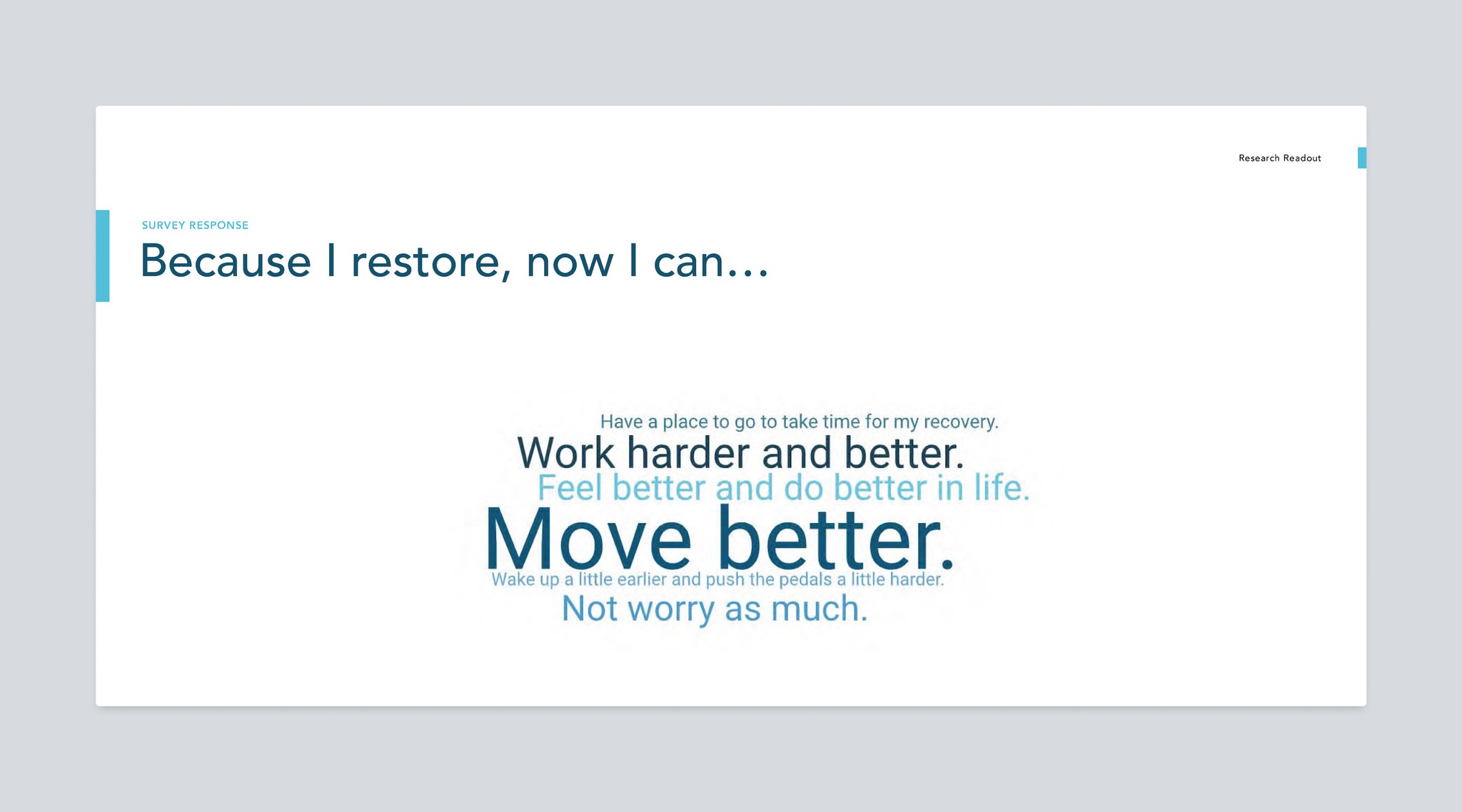



Designing the Solutions
Moving forward, our focus shifted to ideation and developing solutions for the identified problem areas. Based on valuable feedback from users and stakeholders, we zeroed in on eight key areas that required our attention:
Brand Discovery
Scheduling
Onboarding
Pre-Appointment
In-Store Experience
Post-Appointment
Continuous Engagement
Sales
Below, we outline the final solutions we presented to Restore, offering targeted proposals to address each of these crucial aspects.
Designing the Solutions
Moving forward, our focus shifted to ideation and developing solutions for the identified problem areas. Based on valuable feedback from users and stakeholders, we zeroed in on eight key areas that required our attention:
Brand Discovery
Scheduling
Onboarding
Pre-Appointment
In-Store Experience
Post-Appointment
Continuous Engagement
Sales
Below, we outline the final solutions we presented to Restore, offering targeted proposals to address each of these crucial aspects.







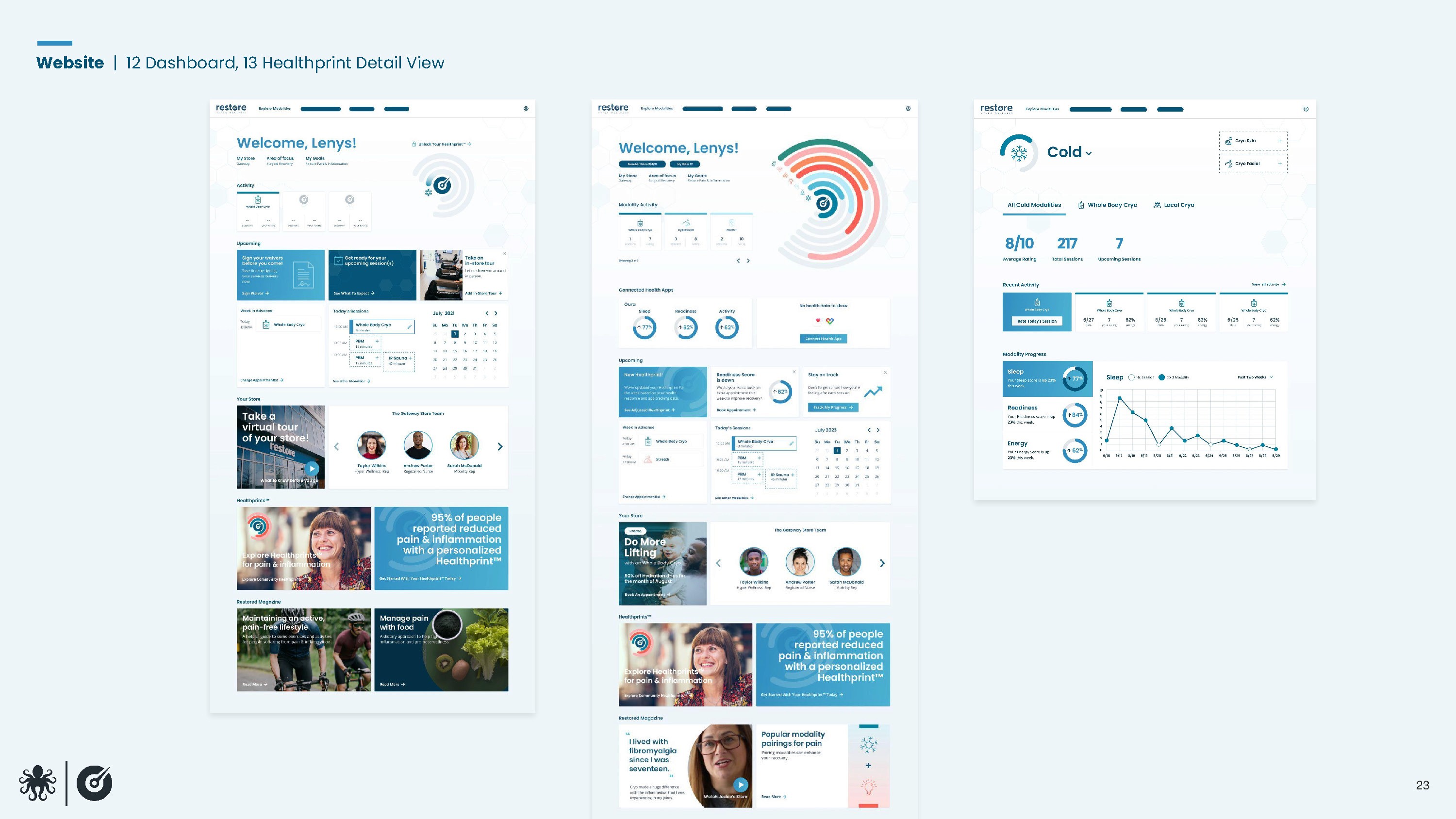

Brand Language
Brand Language
